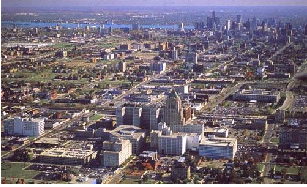Should the social virtues of urbanism and new investment in cities get washed out in the hue and cry over gentrification? John Norquist, CEO of the Congress for the New Urbanism, examines the viability of inner-city development trends in this week's Op-Ed.
 Cities in America have always had an image problem, mostly because they're continuously associated with problems. If it's not one thing it's another. Thomas Jefferson held up the agrarian ideal as preferable to urban life (why shouldn't everyone live on a plantation with a thousand slaves like he did?). Cities were associated with disease, crime, poverty, sin and degradation by reformers such as Jacob Riis, Jane Addams and evangelist Billy Sunday. After World War II, fueled by pro sprawl housing and highway programs, cities declined. Urban race riots made the decline even more apparent ("Will the last one to leave please turn out the lights?"). Even as late as 1991 when its murder rate peaked, New York City's real estate market and population looked like they might be on the way down. And so late 20th century urban policy focused on strategies to attract people and capital back to cities. When signs of revitalization appeared in the strongest of the big cities -- New York, Chicago, San Francisco -- the policy focus adjusted to include concern for a new problem, displacement of the urban poor by the affluent.
Cities in America have always had an image problem, mostly because they're continuously associated with problems. If it's not one thing it's another. Thomas Jefferson held up the agrarian ideal as preferable to urban life (why shouldn't everyone live on a plantation with a thousand slaves like he did?). Cities were associated with disease, crime, poverty, sin and degradation by reformers such as Jacob Riis, Jane Addams and evangelist Billy Sunday. After World War II, fueled by pro sprawl housing and highway programs, cities declined. Urban race riots made the decline even more apparent ("Will the last one to leave please turn out the lights?"). Even as late as 1991 when its murder rate peaked, New York City's real estate market and population looked like they might be on the way down. And so late 20th century urban policy focused on strategies to attract people and capital back to cities. When signs of revitalization appeared in the strongest of the big cities -- New York, Chicago, San Francisco -- the policy focus adjusted to include concern for a new problem, displacement of the urban poor by the affluent.
With urban living regaining popularity, reinvestment has spread to some of the smaller markets, as has the concern about displacement or gentrification. Actually, the concern about gentrification seems to be spreading even faster than real estate price appreciation. For example, it's spread to mid-size Midwest cities like Cleveland, Cincinnati and Pittsburgh that went decades with little private sector investment in new housing construction. While this market failure has many legitimate explanations such as redlining and racism, the fact was that demand to live in these cities was low. People, particularly middle-class and affluent whites, were fleeing the city to the suburbs. Rents and sale prices declined or stagnated, and when rents decline, investment shifts to other places. This was doubly bad for the poor. A deteriorating real estate market meant little investment in repair and maintenance of old urban housing stock and thus declining housing quality. It also meant the decline and abandonment of the jobs base, tax base, and retail and service structure that had served the departed middle class. Furthermore, because the homogenous low-density suburban development typically allows little if any affordable housing, the poor could not easily follow the flight to the suburbs. The only measurable advantage from sprawl for those left behind in the city is low rent.
When consumer demand returns to an urban market, costs and benefits compete for peoples' attention. Bad news: rents will rise. Good news: jobs, tax base, economic structure and investment return. People, no doubt, would love to pay low rent and experience neighborhood economic prosperity at the same time, but this is difficult unless others -other taxpayers? -- subsidize rising rent payments.

In cities with warm, but not quite red-hot housing markets, new housing replaces some of that lost to disinvestment and rents rise slowly, along with benefits such as neighborhood safety, improved transit service, and less time spent traveling to work or stores. In places where rents are stagnant, the discussion of gentrification can lead to government remedies for problems that don't exist yet and may actually chill development as regulatory burdens are layered on prospective projects.
One hopeful characteristic of successful urban redevelopment is that, by its nature, it often includes a wider variety of housing types at a wider spread of price points than sprawl. Less pricey units can be placed in the same building or on the same block with expensive dwellings. For example, people with impressive views pay more than those in units facing the alley. Unlike sprawl, urban infill and rehabilitation at least offer the possibility of people of various incomes living in close proximity.
The social virtues of urbanism and the cost-benefit discussion of new investment in cities tend to get washed out in the hue and cry over "gentrification" when some local activists, CDCs and armchair liberals assume the heroic mantle of protectors of the poor. While their outrage at urban developers is no doubt self-gratifying, it presents the existing residents of urban neighborhoods a very distorted picture of the costs and benefits of potential redevelopment. If allowed to decide for themselves, low-income people might choose to divert some of their scarce income to paying higher rents and thus take advantage of the benefits of living in improving neighborhoods. In fact, research by Lance Freeman, Columbia University Professor of Urban Planning, found that low-income residents were no more likely to move from gentrifying neighborhoods than those not experiencing gentrification. He found that many people valued other benefits more than low rents such as lower crime and restored amenities like shopping or better access to jobs.

Of course, other factors besides renewed investment in cities have left poor and lower middle class people struggling. Their payroll taxes have gone up over the last 25 years while federal taxes on the rich have dropped, leaving working Americans to shoulder more of the burden. The globalization of the manufacturing sector has forced workers to seek other types of employment, some of it at lower wages. While interest rates remain low, a housing bubble limits the home ownership opportunities of the working poor. At a summit this spring hosted by the Congress for the New Urbanism at Wingspread, housing experts from across the political spectrum explored a number of promising policy responses -- including making urban neighborhoods with diverse housing stock legal in more communities and replacing inefficient housing programs with an expanded earned-income tax credit that would help low- and moderate-income people earn extra money and spend it on their own priorities -- perhaps housing, perhaps not. It's understandable that those in the housing business would want government money devoted to housing, but if ending poverty is the goal, it's good to remember that what low-income people ultimately need to escape poverty is more income.
Against this larger backdrop, the gentrification issue is best understood as nuanced with costs and benefits. It's also better understood in local context, i.e. it is genuinely a debatable issue in San Francisco or Manhattan, but a totally phony issue in Detroit or Buffalo. Some places fall in the middle of the spectrum. Faint signs of gentrification can be detected in Baltimore, Philadelphia, Milwaukee and Memphis, but there is so little of it that concern about it should logically be among the lowest priorities. Yet it isn't. The hot rhetoric spewed (perhaps appropriately) in San Francisco gets mindlessly repeated in cities that desperately need investment in their building stock.
Secondly, even if gentrification happens with little or no concern for the poor, it will, in my opinion, in the long run be much better for the low-income population of a metro area than sprawl. The poor have more opportunity in metro areas with compact and economically healthy urban cores. You want the money in the middle where the poor have a better crack at getting some of it. Example: A poor person in Yonkers is a 25-minute ride from Grand Central and one of the densest job markets on earth. A poor person at 6 Mile and Woodward in Detroit can reach 8 Mile Road by an infrequent bus where the Detroit bus system ends and then catch an even more infrequent bus or van to a far-flung suburban manufacturing or office pod. (Let's say it takes 2 hours each way and that would be fast.) My point is that the gentry threat is grossly exaggerated in all but a few mega metros and that the obsession with the perceived threat from the moneyed class slows needed reinvestment in most large US cities.
John Norquist is President of the Congress for the New Urbanism, which holds its annual Congress in Pasadena from June 9-12 where Norquist will host the session, "Beyond Subsidies: The Future of Low-Cost Housing." Visit www.cnuxiii.org for more information.

Trump Administration Could Effectively End Housing Voucher Program
Federal officials are eyeing major cuts to the Section 8 program that helps millions of low-income households pay rent.

Planetizen Federal Action Tracker
A weekly monitor of how Trump’s orders and actions are impacting planners and planning in America.

Ken Jennings Launches Transit Web Series
The Jeopardy champ wants you to ride public transit.

Driving Equity and Clean Air: California Invests in Greener School Transportation
California has awarded $500 million to fund 1,000 zero-emission school buses and chargers for educational agencies as part of its effort to reduce pollution, improve student health, and accelerate the transition to clean transportation.

Congress Moves to End Reconnecting Communities and Related Grants
The House Transportation and Infrastructure Committee moved to rescind funding for the Neighborhood Equity and Access program, which funds highway removals, freeway caps, transit projects, pedestrian infrastructure, and more.

From Throughway to Public Space: Taking Back the American Street
How the Covid-19 pandemic taught us new ways to reclaim city streets from cars.
Urban Design for Planners 1: Software Tools
This six-course series explores essential urban design concepts using open source software and equips planners with the tools they need to participate fully in the urban design process.
Planning for Universal Design
Learn the tools for implementing Universal Design in planning regulations.
Heyer Gruel & Associates PA
Ada County Highway District
Institute for Housing and Urban Development Studies (IHS)
City of Grandview
Harvard GSD Executive Education
Toledo-Lucas County Plan Commissions
Salt Lake City
NYU Wagner Graduate School of Public Service


























